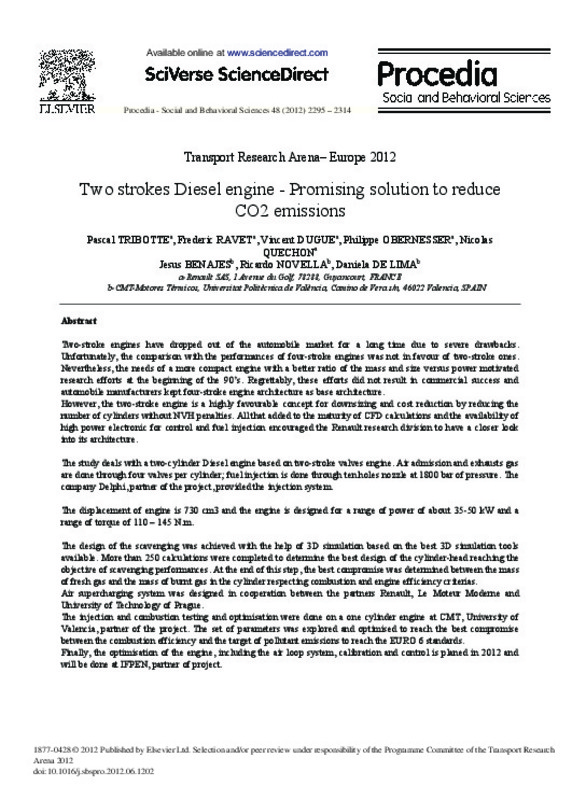JavaScript is disabled for your browser. Some features of this site may not work without it.
Buscar en RiuNet
Listar
Mi cuenta
Estadísticas
Ayuda RiuNet
Admin. UPV
Two strokes Diesel engine - Promising solution to reduce CO2 emissions
Mostrar el registro sencillo del ítem
Ficheros en el ítem
| dc.contributor.author | Tribotte, Pascal
|
es_ES |
| dc.contributor.author | Ravet, Frederic
|
es_ES |
| dc.contributor.author | Dugue, Vincent
|
es_ES |
| dc.contributor.author | Obernesser, Philippe
|
es_ES |
| dc.contributor.author | Quenchon, Nicolas
|
es_ES |
| dc.contributor.author | Benajes Calvo, Jesus Vicente
|
es_ES |
| dc.contributor.author | Novella Rosa, Ricardo
|
es_ES |
| dc.contributor.author | De Lima Moradell, Daniela Andreina
|
es_ES |
| dc.date.accessioned | 2015-02-17T13:12:46Z | |
| dc.date.available | 2015-02-17T13:12:46Z | |
| dc.date.issued | 2012 | |
| dc.identifier.issn | 1877-0428 | |
| dc.identifier.uri | http://hdl.handle.net/10251/47215 | |
| dc.description.abstract | Two-stroke engines have dropped out of the automobile market for a long time due to severe drawbacks. Unfortunately, the comparison with the performances of four-stroke engines was not in favour of two-stroke ones. Nevertheless, the needs of a more compact engine with a better ratio of the mass and size versus power motivated research efforts at the beginning of the 90's. Regrettably, these efforts did not result in commercial success and automobile manufacturers kept four-stroke engine architecture as base architecture. However, the two-stroke engine is a highly favourable concept for downsizing and cost reduction by reducing the number of cylinders without NVH penalties. All that added to the maturity of CFD calculations and the availability of high power electronic for control and fuel injection encouraged the Renault research division to have a closer look into its architecture. The study deals with a two-cylinder Diesel engine based on two-stroke valves engine. Air admission and exhausts gas are done through four valves per cylinder; fuel injection is done through ten holes nozzle at 1800 bar of pressure. The company Delphi, partner of the project, provided the injection system. The displacement of engine is 730 cm3 and the engine is designed for a range of power of about 35-50 kW and a range of torque of 110 - 145 N.m. The design of the scavenging was achieved with the help of 3D simulation based on the best 3D simulation tools available. More than 250 calculations were completed to determine the best design of the cylinder-head reaching the objective of scavenging performances. At the end of this step, the best compromise was determined between the mass of fresh gas and the mass of burnt gas in the cylinder respecting combustion and engine efficiency criterias. Air supercharging system was designed in cooperation between the partners Renault, Le Moteur Moderne and University of Technology of Prague. The injection and combustion testing and optimisation were done on a one cylinder engine at CMT, University of Valencia, partner of the project. The set of parameters was explored and optimised to reach the best compromise between the combustion efficiency and the target of pollutant emissions to reach the EURO 6 standards. Finally, the optimisation of the engine, including the air loop system, calibration and control is planed in 2012 and will be done at IFPEN, partner of project. The objectives, the design process, the major technical breakthrough as well as its detailed results will be presented in this paper. | es_ES |
| dc.description.sponsorship | The work was split between the partners of the project supported by the European Commission. | |
| dc.language | Inglés | es_ES |
| dc.publisher | Elsevier | es_ES |
| dc.relation | European Community funding in POWERFUL integrated platform | es_ES |
| dc.relation.ispartof | Procedia - Social and Behavioral Sciences | es_ES |
| dc.rights | Reconocimiento - No comercial - Compartir igual (by-nc-sa) | es_ES |
| dc.subject | Two-Stroke Engine | es_ES |
| dc.subject | Diesel engines | es_ES |
| dc.subject | Combustion efficiencies | es_ES |
| dc.subject.classification | MAQUINAS Y MOTORES TERMICOS | es_ES |
| dc.title | Two strokes Diesel engine - Promising solution to reduce CO2 emissions | es_ES |
| dc.type | Artículo | es_ES |
| dc.type | Comunicación en congreso | |
| dc.identifier.doi | 10.1016/j.sbspro.2012.06.1202 | |
| dc.rights.accessRights | Abierto | es_ES |
| dc.contributor.affiliation | Universitat Politècnica de València. Instituto Universitario CMT-Motores Térmicos - Institut Universitari CMT-Motors Tèrmics | es_ES |
| dc.contributor.affiliation | Universitat Politècnica de València. Departamento de Máquinas y Motores Térmicos - Departament de Màquines i Motors Tèrmics | es_ES |
| dc.description.bibliographicCitation | Tribotte, P.; Ravet, F.; Dugue, V.; Obernesser, P.; Quenchon, N.; Benajes Calvo, JV.; Novella Rosa, R.... (2012). Two strokes Diesel engine - Promising solution to reduce CO2 emissions. Procedia - Social and Behavioral Sciences. 48:2295-2314. doi:10.1016/j.sbspro.2012.06.1202 | es_ES |
| dc.description.accrualMethod | S | es_ES |
| dc.relation.conferencename | Conference on Transport Research Arena | |
| dc.relation.conferencedate | April 23-26, 2012 | |
| dc.relation.conferenceplace | Atenas, Greece | |
| dc.relation.publisherversion | http://dx.doi.org/10.1016/j.sbspro.2012.06.1202 | es_ES |
| dc.description.upvformatpinicio | 2295 | es_ES |
| dc.description.upvformatpfin | 2314 | es_ES |
| dc.type.version | info:eu-repo/semantics/publishedVersion | es_ES |
| dc.description.volume | 48 | es_ES |
| dc.relation.senia | 227731 |








